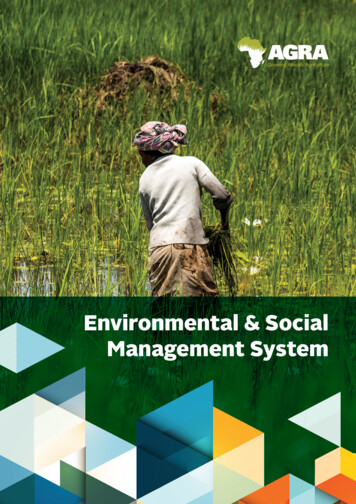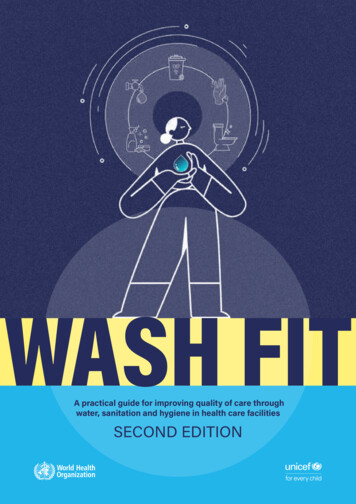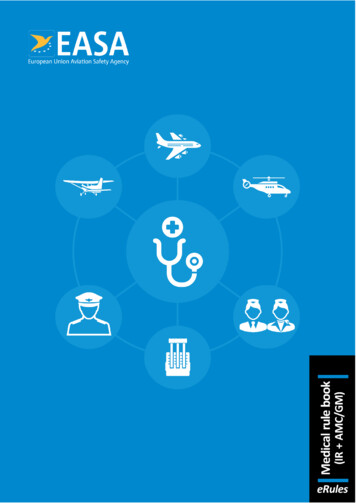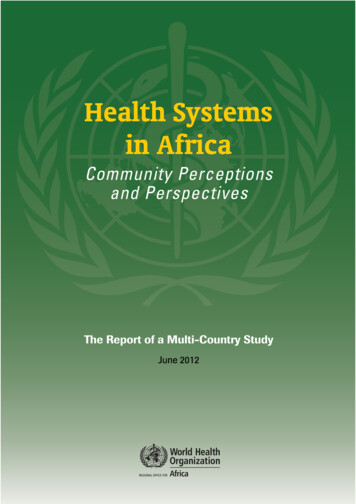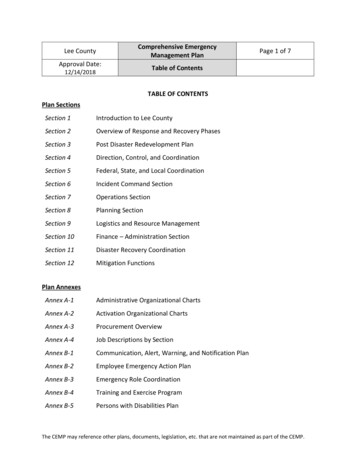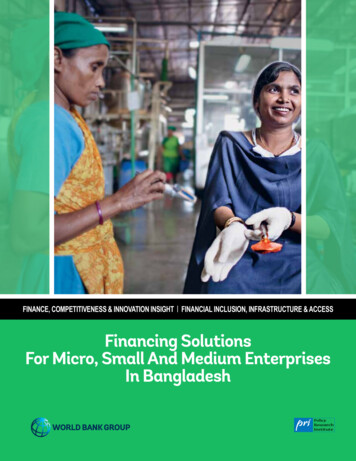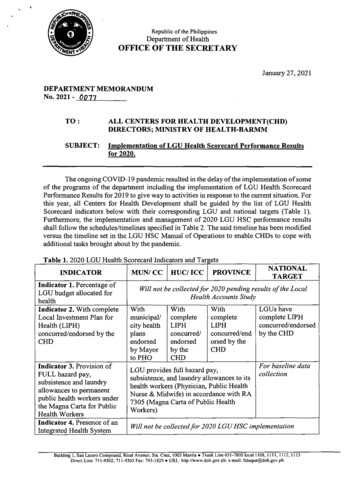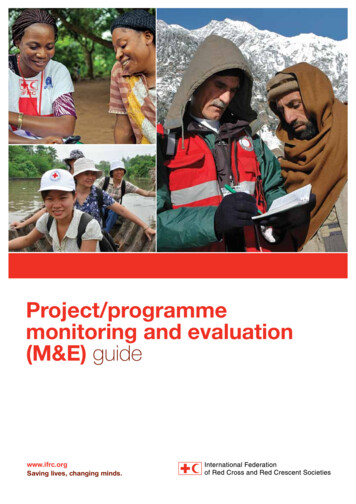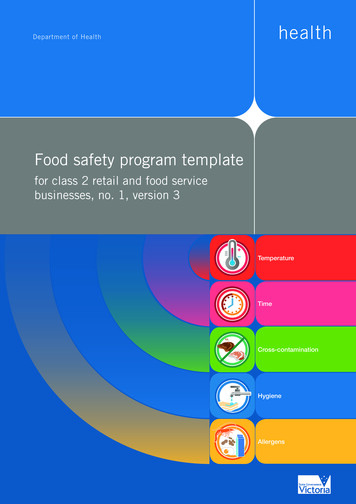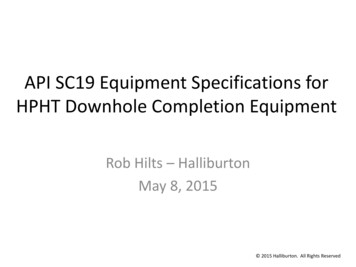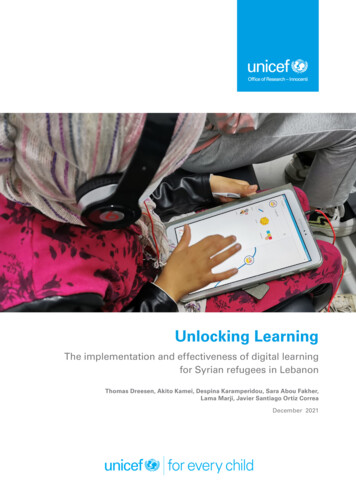
Transcription
ANNEX T-2TEMPLATE: FOOD COMMODITY PROTECTION PERSUAP FORPHOSPHINE FUMIGATION & CONTACT PESTICIDESThe following is a fill-in template for a Pesticide Evaluation Report and Safer Use Action Plan(PERSUAP) for Commodity Protection by Phosphine Fumigation & Contact Pesticides, and one of thetools of the Fumigation PEA.New Food Assistance Programs supporting phosphine fumigation MUST have an approved FumigationPERSUAP in place BEFORE supporting phosphine fumigation. If contact (residual) pesticides are to beused as a complement to fumigation, the Fumigation PERSUAP must also cover their use. (The soleexception is if such the program has another PERSUAP, e.g. for use of pesticides in agricultural production,and contact pesticide is covered by this PERSUAP.)For additional information, refer to Annex T-1 of the Fumigation PEA, which describes the purpose of thePERSUAP and summarizes the requirements it establishes.The template is highly detailed with respect to Aluminum Phosphide. It is necessarily less detailed for contact(residual) pesticides, as there are a large number of potential products that may be used. Examples of simplePERSUAPs in USAID’s database of 22 CFR 216 documentation can provide guidance as to how to fill in thevarious fields.In areas where Partners are unable to meet the implementation and reporting conditions describedherein, they must request an exception from USAID. All substantive changes must be approved.Step 1: click: http://gemini.info.usaid.gov/egat/envcomp/Step 2: Click on the "Advanced Search" tabStep 3: in the first field "Source Document Text Search" enter the name of the contact pesticide that you seekto use.Step 4: Click on “search” and then on the “PDF” link to view the resulting documents.USAID PHOSPHINE FUMIGATION PEA – TOOLS ANNEX – NOV 2013 – PAGE #4
This is a Food Commodity Protection PERSUAP template. Instructions: Review full text of document. Fill in orreplace all green-highlighted fields. If a contact pesticide is to be used, include/fill-in yellow-highlighted fields; otherwise delete.Alter any provided text not applicable to your program; however, be advised that substantive changes to safer use measuresmay not be approved by USAID. If you wish to make a substantive change to this template you must request an exceptionfrom USAID, Delete this box & clear highlighting before submitting to USAID.USAID INITIAL ENVIRONMENTAL EXAMINATION- AMENDMENT FACESHEETPESTICIDE EVALUATION PLAN AND SAFER USE ACTION PLAN (PERSUAP) FORCOMMODITY PROTECTION BY PHOSPHINE FUMIGATION & CONTACT PESTICIDESActivity/Project Title: [INSERT TITLEContract/Award Name(s) & Number(s) (if known) : Insert contract/ award name and numberGeographic Location: Insert implementation country and region e.g. Ethiopia/AfricaOperating Unit(s):DCN and Date of Original IEE: insert PEA clearance dateIEE Amendment (Y/N): YESEnv Compl Database link: insert link to PEA on l Funding Amount (optional field):Life of project Amount:Implementation Start/End:IEE Prepared by: Insert name, organization, contact infoDate Prepared: Updated September 2015Implementing Partner(s):Recommended Threshold Determination:Categorical ExclusionNegative DeterminationWith ConditionsPEA Expiration Date (if any): September 2020Positive DeterminationDeferralNote: SUAP requirements (see sections 6 and 7 of this PERSUAP Template) will be incorporated as neededinto program Detailed Implementation Plan (DIP) and BudgetSUMMARY OF FINDINGSPhosphine fumigation of food commodities and complementary use of the contact pesticide [insert productname] in and around food commodity warehouses for the XXX Program is approved subject to compliancewith the Safer Use Action Plan (SUAP) that constitutes sections 6 and 7 of the PERSUAP Template. The SUAPimposes the mitigation requirements (safer use conditions) established by the Programmatic EnvironmentalAssessment “Phosphine Fumigation of Stored Agricultural Commodity.”LIST OF CONDITIONSCondition 1: A Fumigation Management Plan (FMP) must describe the fumigation process, includingfor fumigant pesticide use, storage, transport and disposal. The FMP and the actual fumigation process willsubstantively conform to the plan provided as Tool T-3 (Template of the FMP) of the Fumigation PEA. ThisFMP must include the following details on the fumigation equipment:1a). Gas monitoring Equipment: Brand name, model and type of phosphine gas monitoringequipment (electrochemical, photo-ionization or tube type)1b) Personal Protection Equipment: including gas canister masks or self-contained breathingapparatus1c) Gas impermeable tarps: resistant to UV light and tearing along both length and width, andimpermeable to phosphine gas
The TOPS Warehouse Safety Guidelines and Posters detailing the safety measures to take before, duringand after fumigation, as well as proper disposal and cleanup procedures after fumigation can also beconsulted.Condition 2: Any additional Contact Pesticide(s) used in warehouse commodity protection must be limitedto the pesticide(s) authorized by the PERSUAP and should substantively conform to contact pesticide bestpractices as set out in Fumigation PEA Annex T-6 on “IPM PRACTICES & INSPECTION CHECKLISTFOR USAID-FUNDED COMMODITIES AND WAREHOUSES”. The PERSUAP will also includeinformation on the safe use measures and personal protection equipment used in the application of thecontact pesticide(s), as well as contact pesticide storage, transport and disposal.Condition 3: Good Housekeeping and IPM Measures. The implementing partner must fully implementthe daily/weekly warehouse and commodities inspection checklist (Annex T- 6 on IPM PRACTICES) andtake maintenance/corrective actions specified. Compliance with this checklist implements a set of IPMmeasures that are essential complements to fumigation. The implementing partner will also only purchasecommodity that is at 13% or less moisture and distribute stocks as quickly as possible in order to ensure fullprotection against fungal growth, since fungal growth and mycotoxin production cannot be completelycontrolled by phosphine fumigation.Condition 4: Fumigation Contract Language When using a 3rd-Party Fumigation Service Provider, theprovided model RFQ and contract (or substantive equivalent) will be used to procure fumigation services andproposals/quotes will be evaluated based on ability to comply with specified safer use practices, including theprocurement and use of gas monitoring equipment, fumigation and contact pesticide PPE as well as gasimpermeable tarps meeting specified requirements.Condition 5: The implementing partner will actively monitor compliance with the above-listed conditionsand undertake corrective actions as needed.2
APPROVAL OF ENVIRONMENTAL ACTION RECOMMENDED FOR:Fumigation PERSUAP for [Name of Program]A. CLEARANCEDateMission Environmental OfficerDateRegional Environmental Advisor/Officer*DateMission DirectorDateA/CORDateOffice Director (as applicable)B. CONCURRENCEDateBureau EnvironmentalOffice1Accepted:Not Accepted:*Mandatory for non-presence countriesRefer to the appropriate office: http://www.usaid.gov/our e-officers13
USAID INITIAL ENVIRONMENTAL EXAMINATION- AMENDMENTPesticide Evaluation Plan and Safer Use Action Plan (PERSUAP) forCommodity Protection by Phosphine Fumigation & Contact PesticidesUSAID PROGRAM DATAProgram Name:Awardee:Country/Region:Period of Performance:Insertinsert organizationinsert country/regionX years (start date – end date)1. PURPOSE AND SCOPE OF PERSUAPUpon approval, this Fumigation PERSUAP, submitted as an amendment to the [insert program name] IEEwill authorize phosphine fumigation of insert program name food commodities. This PERSUAP will alsoauthorize complementary use of the contact pesticide(s) insert product names in and around emptywarehouses for these commodities. Fumigation and contact pesticide use is authorized subject to strict saferuse conditions. As described herein, use of fumigation and contact pesticide is necessary for successfulprogram implementation.Formally, approval of this PERSUAP will assign a negative determination to phosphine fumigation and useof the contact pesticide [insert product name], subject to the condition that the Safer Use Action Planprovided as Sections 6 and 7of the PERSUAP Template, is fully implemented.This PERSUAP satisfies the requirements of 22 CFR 216.3(b) (USAID Pesticide Procedures) and puts inplace the safer use requirements (mitigation measures) established by the USAID ProgrammaticEnvironmental Assessment “Phosphine Fumigation of Stored Agricultural Commodity” (Henceforth the“Fumigation PEA.”)22. PROGRAM DESCRIPTIONProvide a BRIEF (not more than 1 or 2 paragraph description) of the program.3. COMMODITY PROTECTION NEEDSList the food commodities being managed. Provide general information about the length of timecommodities are typically stored in primary and secondary warehouses. List known pest problems andsuccinctly describe consequences of failure to adequately control commodity pests. Do not spend more than1 or 2 paragraphs on this section.The Fumigation PEA establishes that food commodity protection by fumigation addresses food commodityprotection needs that can rarely be completely replaced by other methods. It also establishes that thecomplementary use of contact pesticide in and around warehouses is usually an integral part of the fumigationprocess to kill insects escaping fumigation and prevent re-infestation of the commodity.2Approved (insert date). Available on: umigationPEAFeb24 2014.pdf4
4. PROPOSED PESTICIDE(S).This PERSUAP requests approval to use aluminum phosphide3 as an indoor fumigant at storage facilities forthe following commodities: [insert commodity names]. Use is requested of both pellet and tablet formulationswith 55-57% active ingredient.This PERSUAP also requests approval to use the contact pesticide insert product name as a complement tofumigation in and around food commodity warehouses.5. FACTOR ANALYSIS PER 22 CFR 216.3(B)(1)(I)(A THROUGH L)This section provides the 12-factor analysis required by 22 CFR 216.3(b) to allow USAID to make adetermination as to whether to permit use of a proposed pesticide and to establish appropriate safer useconditions.Separate Factor Analyses are provided for (1) Aluminum Phosphide and (2) insert name of contact pesticide.FACTOR ANALYSIS FOR ALUMINUM PHOSPHIDEANALYSIS FACTORANALYSIS(a) USEPAregistration status ofthe proposedpesticide.Aluminum phosphide is an inorganic phosphide registered in the U.S. under CASNumber 20859-73-8 with U.S. EPA PC Code 066501. Aluminum phosphide is aRestricted Use Pesticide (RUP) so in the US may be purchased and used only bycertified applicators. It is in EPA’s toxicity Class I, and products containing it must bearthe signal word DANGER. In contact with water, it produces a toxic gas hydrogenphosphide. Aluminum phosphide is widely used for fumigation of food commodities andstructures.Partner countryregistration status(b) Basis forselection of thepesticideProvide analogous partner country registration information and any restrictionsestablished by this registration.The selection of aluminum phosphide is based on: efficacy against pests of stored grains,low cost, availability in country, and registration in country.If used in accordance with safeguards, aluminum phosphide is not expected to haveadverse environmental impacts; this is also a factor in its selection.Efficacy and the effectiveness of use safeguards have already been assessed extensively inthe Fumigation PEA and thus are not addressed further here.The selection was also based on the availability of a qualified professional serviceprovider for phosphine fumigation.(c) Extent to whichthe proposedpesticide use is, or3The Safer Use Action Plan requires compliance with Fumigation PEA Annex T-6 on IPMPRACTICES. This checklist contains good-housekeeping based Integrated PestManagement (IPM) practices that are essential complements to fumigation, includingIt should be noted here that Phosphine Fumigation refers to fumigation with aluminum phosphide5
could be, part of anIPM programdaily sanitation of the warehouse; clearing warehouse surroundings of weeds on aweekly basis; daily inspections for pests; and strictly adhering to the first in first out(FIFO) rule to minimize the storage time of the commodities in the warehouse.(List any additional IPM food commodity protection practices to which the program iscommitting.)(d) Proposedmethod or methodsof application,including theavailability ofapplication andsafety equipmentAluminum phosphide will be used for indoor fumigation of warehoused foodcommodities in sheeted stacks only. It should be noted that the uses specified forAluminum phosphide in this PERSUAP DO NOT cover outdoor fumigation and soilfumigation.Via the Fumigation Management Plan, the SUAP requires that fumigation followacceptable technical practices specified in Annex T-7 on “FUMIGATION ANDCONTACT PESTICIDE BEST MANAGEMENT PRACTICES” of theFumigation PEA. These include, among others, use of appropriate personal protectionequipment, including respirators, maintenance of an exclusion zone that only fumigationpersonnel can enter for duration of the fumigation (7-10 days or more)4, and phosphinegas monitoring for efficacy and hazard.Note if the program’s fumigation services provider will provide PPE and monitoringequipment, or if the program will do so.(e) Any acute andlong-termtoxicologicalhazards, eitherhuman orenvironmental,associated with theproposed use, andmeasures availableto minimize suchhazards.The potential toxicological effects of aluminum phosphide are well covered byEXTOXNET, and Extension Toxicology Network.* The Fumigation PEA includes detailsof acute human health exposure and potential impacts to fumigators, other on-siteworkers, visitors, nearby residents and beneficiaries. In summary: The main routes of exposure to aluminum phosphide are through inadvertentingestion or inhalation during fumigation of the highly toxic gas. Symptoms of mild to moderate acute aluminum phosphide toxicity include nausea,abdominal pains, tightness in chest, excitement, restlessness, agitation and chills.Symptoms of more severe toxicity include diarrhea, cyanosis, difficulty breathing,pulmonary edema, respiratory failure, tachycardia and hypotension, dizziness and ordeath. The available evidence for reproductive effects in animals suggests that they are notlikely in humans under normal conditions. No evidence is available to supportteratogenic effects in humans or to support the ability of aluminum phosphide tocause mutations or increase mutation rates. There is no evidence of aluminum phosphide having a negative impact on soil orground water. It breaks down spontaneously in the presence of water to form agaseous product, thus is non-persistent and non-mobile in soil and poses no risk togroundwater. For the same reasons, it is unlikely that aluminum phosphide orphosphine will contaminate surface waters. The USEPA has determined that uses of aluminum phosphide will not generallycause unreasonable adverse effects to humans or the environment if used inThere is some controversy over the optimal exposition time to respect from fumigating the warehouse to aerating itafter the phosphine gas has dissipated, for efficient pest control. For any clarifications, please contact the DCHA BEO(eclesceri@usaid.gov)46
accordance with the approved use directions and revised precautionary statementsprescribed by the registration standard. Requirements for acute toxicity data havebeen waived because of the well-known extreme inhalation toxicity of phosphinegas, which it generates. Accordingly, aluminum phosphide has been placed intoxicity category I, the highest toxicity category.Tolerances have been established for raw agricultural commodities at a level of 0.1 ppm(40 CFR 180.225); processed foods 0.01 ppm (21 CFR 193.20); and animal feeds 0.1ppm (40 CFR 561.40). Finished food and feed must be held and aerated 48 hours priorto being offered to the consumer.Via the Fumigation Management Plan, the SUAP requires that fumigation followacceptable technical practices specified in Annex T-7 on BEST MANAGEMENTPRACTICES of the Fumigation PEA. These include, among others, use of appropriatepersonal protection equipment, including respirators, maintenance of an exclusion zonethat only fumigation personnel can enter for duration of the fumigation (7-10 days ormore), and phosphine gas monitoring for efficacy and net/24d-captan/aluminum-phosphide-ext.html(f) Effectiveness ofthe requestedpesticide for theproposed use.Aluminum Phosphide is registered by US EPA as stored grain pesticide. It is consideredthe most effective method of controlling stored commodity pests, especially when usedin an IPM framework, as described above in (c).In-country experience is that this fumigant is very effective in killing the intended targetsnoted in section 3 within the prescribed seven to ten day fumigation time.Describe any resistance reported or known to you. If none, “We are not aware of anyinstances of resistance to aluminum phosphide by the intended target pests.”(g) Compatibility ofthe proposedpesticide use withtarget and nontarget ecosystems.As an indoor fumigant, aluminum phosphide presents risks to fumigators and thoseworking or living nearby, but there is not a “target ecosystem” of concern.(h) The conditionsunder which thepesticide is to beused, includingclimate, flora, fauna,geography,hydrology, and soilsAs noted, aluminum phosphide will be used solely for indoor fumigation of warehousedfood commodities: Briefly describe the warehouse(s) in which fumigation will occur,their setting, proximity to other structures & their uses.Indoor use, non-persistence and non-mobility in soil, negligible potential to contaminatesurface waters, and a short half-life in air of 5 hrs (daylight) mean that aluminumphosphide has essentially no interaction with or impact on non-target ecosystems.Indoor use, non-persistence and non-mobility in soil, and negligible potential tocontaminate surface waters (see “factor e,” analysis, above) mean that geography,hydrology and soils have negligible bearing on safety, efficacy or appropriateness.Climate is relevant only in that extremely dry air can retard formation of phosphine gasfrom phosphine tablets, requiring appropriate adjustments to fumigation protocols. Thisis/is not anticipated to be an issue in XXX, where typical indoor temperatures will7
range between X⁰C & Y⁰C and humidity between X and Y%.(i) The availabilityand effectiveness ofother pesticides ornonchemical controlmethodsThe fumigation PEA assesses the effectiveness and availability of non-chemical controlmethods, including weekly inspection for signs of rodents, weeding the perimeteraround the warehouse, cleaning up spills and trash, ensuring that the warehouse doors,roofs, walls etc. are in good condition (Refer to Annex T-6 on IPM PRACTICES. Asnoted, the Safer Use Action Plan requires good housekeeping IPM measures such asdaily sanitation of the warehouse and weekly clearing of warehouse surroundings ofweeds; daily inspections for pests and strictly adhering to the first in first out (FIFO)rule to minimize the storage time of the commodities in the warehouse.The complementary contact pesticide [insert name] will be used to kill insects escapingfumigation and prevent re-infestation of the commodity. As documented by the PEA,such complementary use of contact pesticide(s) in and around warehouses is usually anintegral part of the fumigation process.(j) The requestingcountry's ability toregulate or control thedistribution, storage,use and disposal of therequested pesticidePartner country registration status is documented under Factor A, above.(k) The provisionsmade for training ofusers and applicatorsRegardless of partner country licensing, describe the training standard of fumigatorservice provider personnel.(l) The provisions madefor monitoring the useand effectiveness of thepesticideThe SUAP requires a Fumigation Management Plan that serves as detailed log of eachfumigation episode. The FMP requires efficacy monitoring of phosphine gasconcentrations to better assure that required concentrations are attained for therequired period. This is critical to the efficacy of the individual fumigation and topreventing emergence of resistance. Monitoring of commodities for infestation is aroutine element of program management; quick re-infestations are the primary indicatorthat fumigation is ineffective.Note whether phosphine fumigation requires a license in your partner country, and therequirements for obtaining such a license. Note whether such licensing is meaningfullyenforced.FACTOR ANALYSIS FOR [INSERT NAME OF CONTACT PESTICIDE]ANALYSISANALYSIS FACTOR(a) USEPAregistration status ofthe proposedpesticide.Provide EPA registration status. Note that the pesticide must be registered for the sameor similar uses by US EPA.Provide analogous partner country registration information and any restrictionsestablished by this registration. Note that the pesticide must be registered in thepartner country AND by US EPA.Partner countryregistration status(b) Basis forselection of thepesticideAvailability, cost, efficacy, and relatively low toxicity to humans and non-targetorganisms should be key selection factors.(c) Extent to whichThe Safer Use Action Plan (SUAP) requires compliance with Fumigation PEA Annex T-68
the proposedpesticide use is, orcould be, part of anIPM programon IPM PRACTICES. This checklist contains good-housekeeping based Integrated PestManagement (IPM) practices that are essential complements to fumigation, includingdaily sanitation of the warehouse; clearing warehouse surroundings of weeds on aweekly basis; daily inspections for pests; and strictly adhering to the first in first out(FIFO) rule to minimize the storage time of the commodities in the warehouse.(List any additional IPM food commodity protection practices to which the program iscommitting. )(d) Proposedmethod or methodsof application,including theavailability ofapplication andsafety equipment(e) Any acute andlong-termtoxicologicalhazards, eitherhuman orenvironmental,associated with theproposed use, andmeasures availableto minimize suchhazards.(f) Effectiveness ofthe requestedpesticide for theproposed use.(g) Compatibility ofthe proposedpesticide use withtarget and nontarget ecosystems.(h) The conditionsunder which thepesticide is to beused, includingclimate, flora, fauna,geography,hydrology, and soils(i) The availabilityand effectiveness ofother pesticides ornonchemical controlmethodsDescribe any resistance reported or known to you.This pesticide will be used solely for spraying the interior and immediate perimeter ofempty warehouses. The settings for these warehouses are described under the factoranalysis for aluminum phosphide, above.Follow with additional relevant information.The fumigation PEA assesses the effectiveness and availability of non-chemical controlmethods. As noted, the Safer Use Action Plan requires good housekeeping IPMmeasures such as daily sanitation of the warehouse and weekly clearing of warehousesurroundings of weeds; daily inspections for pests and strictly adhering to the first infirst out (FIFO) rule to minimize the storage time of the commodities in the warehouse.The complementary contact pesticide [insert name] will be used to kill insects escapingfumigation and prevent re-infestation of the commodity. As documented by the PEA,9
such complementary use of contact pesticide in and around warehouses is usually anintegral part of the fumigation process.(j) The requestingcountry's ability toregulate or control thedistribution, storage,use and disposal of therequested pesticide(k) The provisionsmade for training ofusers and applicators(l) The provisions madefor monitoring the useand effectiveness of thepesticidePartner country registration status is documented under Factor A, above.XXX does/does not have6. FINDINGSIn consequence of the analysis above, and the referenced Fumigation PEA, warehouse food commodityphosphine fumigation for program name food commodities and use of the complementary contact pesticides[insert name(s)] is [are] recommended for approval subject to full compliance with and implementation of theSafer Use Action Plan (SUAP) that constitutes the following section. The SUAP imposes on program namephosphine fumigation and complementary contact pesticide use the mitigation measures established by theFumigation PEA.In summary, these conditions are:1. Implementation of good-housekeeping IPM Measures that are essential complements tofumigation per Fumigation Annex T-5 “PHOSPHINE FUMIGATION SERVICES CONTRACT”.2. Implementation of a Fumigation Management Plan for each fumigation event substantivelyconforming to the plan provided as Annex T-3 “FUMIGATION MANAGEMENT PLAN (FMP) FORPHOSPHINE FUMIGATION OF FOOD COMMODITIES IN SHEETED STACKS” to theFumigation PEA.53. Complementary Use of Contact Pesticides will (1) be limited to the pesticide(s) authorized by thisPERSUAP and substantively conform to contact pesticide best practices as set out in Fumigation PEAAnnex T-6 on IPM PRACTICES.64. Storage and Transport of Aluminum Phosphide and Contact Pesticides, if under programcontrol, will substantively conform to contact pesticide best practices as set out in Fumigation PEAAnnex T-6 on PM PRACTICES, EXCEPT for changes specified below and/or subsequently approvedby the USAID Bureau for Democracy, Conflict and Humanitarian Assistance (DCHA) BureauEnvironmental Officer (BEO).5. Food and feed commodities that have been fumigated with phosphine must be held and aerated for 48hours prior to distribution.6. Monitoring and Corrective Actions. Program will actively monitor compliance with above-listedconditions and undertake corrective actions as needed.5EXCEPT as noted in the SUAP6Ibid.10
Formally, upon approval of this PERSUAP, the program name IEE is amended so that phosphinefumigation activities receive a 22 CFR 216 negative determination subject to the condition of compliancewith the SUAP provided below.7. SAFER USE ACTION PLAN (SUAP)The SUAP is provided as a mandatory “safer use action plan and compliance tracker” form. This formboth enumerates safer use requirements and sets out how program name will implement these requirements.Additionally, it serves as a compliance tracking and reporting tool, and will be submitted annually with regularreporting requirements.Note: with respect to fumigation, the Safer Use Action Plan from satisfies the requirement for an environmental mitigation andmonitoring plan (EMMP). The program EMMP should simply incorporate the SUAP by reference.11
[INSERT USAID PROGRAM NAME]FUMIGATION SAFER USE ACTION PLANCompletion of this form is an integral part of the PERSUAP and must be submitted annually with regular reporting requirements.PROGRAM & CONTACT INFORMATIONDATE OF ANNUAL REPORTINGSUBMISSION:AwardeeAnnual Update #1Program NameAnnual Update #2FumigationCompliance LeadName and titleAnnual Update #3ContactInformationEmail & telephoneAnnual Update #4FUMIGATION LOG (record all fumigation events since the last annual update)DatesLocation(Town or City)WarehouseTypeP*S*Commodity & Quantity FumigatedKey Exceptions/Incidents per FMP log.T*P Primary, S Secondary, T Tertiary12
REQUIRED COMPLIANCE MEASURESSTATUS OF COMPLIANCE ACTIONS(Place an X where applicable)1.Good Housekeeping IPM Measures are implemented.YesNoIf “No”, please explain why, and detail whencompliance is expected to take place:2.A Fumigation Management Plan is implemented, with the required gasmonitoring equipment, PPE and gas impermeable tarps for fumigation.YesNoIf “No”, please explain why, and detail whencompliance is expected to take place:3.The Use of Contact Pesticides is limited to pesticides authorized in thisPERSUAP, and proper application, safety measures and PPE requirementsare equally followed.YesNoIf “No”, please explain why, and detail whencompliance is expected to take place:4. Best practices in the storage and transport of Aluminum Phosphide andcontact Pesticides are carried out.YesNoIf “No”, please explain why, and detail whencompliance is expected to take place:5. The third-party Fumigation Service Provider, if used, is in compliance withspecified safer use practicesYesNoIf “No”, please explain why, and detail when13
compliance is expected to take place:6.Compliance monitoring and implementation of corrective actions:YesNoIf “No”, please explain why, and detail whencompliance is expected to take place:REQUESTED EXCEPTIONS AND CHANGES TO SPECIFIED MANAGEMENT PRACTICESEnter here specific requested exceptions or changes to fumigation practices as described in the Fumigation Management Plan (Fumigation PEA Annex T-3) orstorage, transport, and contact pesticide practices per Annex T-6 on IPM PRACTICES. Reference by number & provide justification in each case. Alternately, astrike-through edit of the FMP may be submitted.(insert extra rows if needed)14
The Safer Use Action Plan requires compliance with Fumigation PEA Annex T-6 on IPM PRACTICES. This checklist contains good-housekeeping based Integrated Pest Management (IPM) practices that are essential complements to fumigation, including 3 It should be noted here that Phosphine Fumigation refers to fumigation with aluminum phosphide
